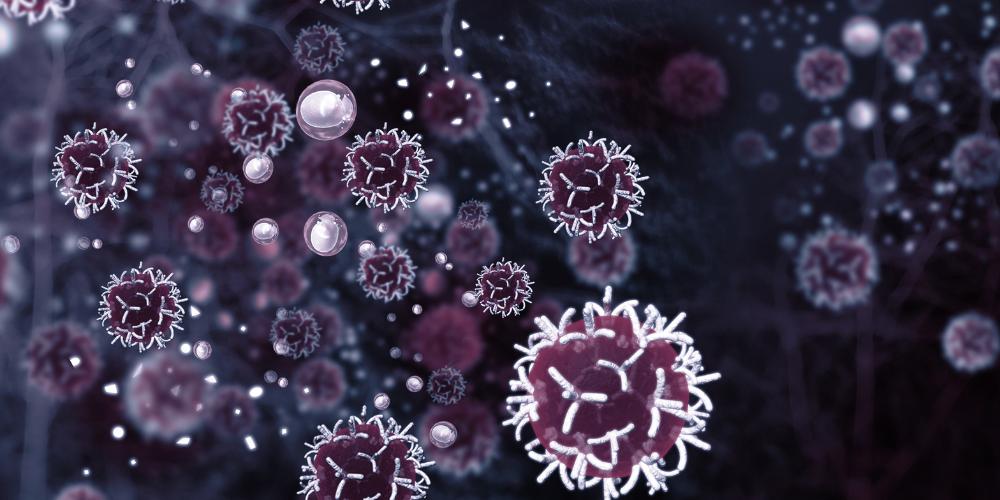IO360º 2024 – Utilization of IO Agents in Adjuvant Disease and Update on Adjuvant Vaccine Studies
In this recap of two adjuvant-focused sessions, we provide readers with an overview of the current IO adjuvant landscape with Dr Alexander Eggermont, and a look into BioNTech’s adjuvant vaccine work, from the 2024 IO360º conference.

Utilization of IO agents in adjuvant disease and the progress that's been made so far
Dr Alexander Eggermont, Chief Scientific Officer, Princess Máxima Center for Pediatric Oncology and Professor, Clinical & Translational Immunotherapy, University Medical Center, Utrecht, provided a helicopter overview of the past 5-6 years of immunotherapy, leading into what he called “Immunotherapy 2.0.”
Dr Eggermont began in melanoma and several noteworthy adjuvant trials: Anti-PD-1s outperformed anti-CTLA-4 (in CheckMate-238), proving nivolumab was better than ipilimumab, and pembrolizumab was better than placebo (in EORTC 1325/KEYNOTE-054), and dabrafenib plus trametinib (in COMBI-AD) was only effective in BRAF-mutant melanoma.
Notable trials
EORTC 18071, with ipilimumab vs placebo
This was the first adjuvant trial in Stage III, lymph node-positive melanoma that led to approval and that had a benefit for all endpoints: Progression-Free Survival (PFS), Relapse-Free Survival (RFS), Distant-Metastasis-Free Survival (DMFS), and Overall Survival (OS).
Dr Eggermont highlighted that even though ipilimumab isn’t used in the adjuvant setting any longer (as CheckMate-238 showed anti-PD-1s outperformed anti-CTLA-4), EORTC 18071 showed the benefit and quality of immunotherapy’s impact: the hazard ratio (HR) in relapse-free survival (0.75) is the same as distant metastasis (0.76) and for overall survival (0.73), translating to absolute benefit of roughly 10% in overall survival.
EORTC 1325/KEYNOTE-054, with lymph node-positive patients randomized between pembrolizumab and placebo
At three years, the HR remained the same (0.50 / 0.56 / 0.57) regardless of stage. Dr Eggermont’s takeaway from KEYNOTE-054 was that the impact in absolute terms will always be the biggest in the highest-risk disease because 70 percent of patients are going to relapse at that point. If you cut the difference of 70% relapses in half by a hazard ratio of 0.50, you have an absolute benefit of 25-30%.
5-year results published in the New England Journal of Medicine Evidence 2023 demonstrated that the impact on RFS is the same as impact on DMFS and PFS after crossover. There will be a landmark analysis in 2026: he predicted that the overall survival benefit will be 12-13% with pembrolizumab.
KEYNOTE-716 and CheckMate-76K
KEYNOTE-716 and CheckMate-76K studied adjuvant pembrolizumab and adjuvant nivolumab, respectively, in the context of non-lymph node-positive melanomas with thick primaries (Stage 2b, 2c and 3b).
In KEYNOTE-716, the impact on RFS is the same as on DMFS; DMFS had an HR of 0.59, same as the HR of lymph node-positive disease (0.56). Dr Eggermont felt that this wasn’t a surprise because the only patients that can benefit from adjuvant therapy are the ones with microscopic residual disease.
mRNA-4157-P201/ KEYNOTE-942
Dr Eggermont touched upon mRNA-4157-P201/ KEYNOTE-942. This was a combination of the Moderna personalized vaccine and pembrolizumab in the adjuvant setting, studied against pembrolizumab as monotherapy, in lymph node-positive melanoma patients. Dr Eggermont highlighted that, in RFS and DMFS, the vaccine showed benefit at roughly one year out from treatment.
What does all of this mean for the future?
First, the data showed that IO is more effective in the adjuvant setting, raising the question, “How are we going to improve on our adjuvant treatment thinking and scenarios?”
Second, there is the need to identify the risk of relapse based on gene expression on the primary node. Dr Eggermont discussed the CP-GEP algorithm. CP-GEP is a non-invasive prediction model for cutaneous melanoma patients that combines clinicopathologic (CP) variables with gene expression profiling (GEP). He showed how the algorithm had identified patients who relapsed, but who were sentinel node negative.
His prediction was that the CP-GEP algorithm would replace sentinel node staging and be useful for the earlier, thinner stages of melanoma (which accounts for 80% of melanoma patients) and be used to identify those who will relapse and therefore should have the discussion as to whether to receive adjuvant treatment.
Next phase of IO
Dr Eggermont ended the presentation by touching on perioperative adjuvant therapy and neoadjuvant immunotherapy, illustrating the benefits through several key studies. The combination has 3 effects: more cures, shorter treatments and less surgery. His argument was that, by going before surgery, you can exploit the lymphocytes in those primary tumors / lymph node metastasis.
S1801 Study
In melanoma, just by rescheduling the first three doses of pembrolizumab to prior to surgery, and 15 doses after, you see greater benefit than just doing adjuvant pembrolizumab (72% of neo had no event versus 49% of adjuvant) with a hazard ratio of 0.58.
OpACIN Trial
The OpACIN trial studied neoadjuvant vs adjuvant with ipilimumab plus nivolumab checkpoint inhibition. The patients on the neoadjuvant arm had greater T clonal diversification and higher volumes. The subsequent OpACIN-neo trial showed that there were almost no relapses in pathologic responders.
PRADO Study
In the PRADO study, looking at neoadjuvant ipilimumab-nivolumab, 60% of patients didn’t need surgery. Those patients had a pathologic complete response of the largest lymph node, and therefore they had no more lymph node dissections, no more surgery, and also they had no more adjuvant therapy.
Dr Eggermont closed with this sentiment: “We will have new standards of care, with more cures, less surgery and less treatment cycles,” and he predicted, “this will be translated into multiple tumor types.”
_________________________________________________________________
Update on BioNTech Adjuvant Vaccine Studies
Mark DeMario, MD, MPH, VP, Clinical Development at BioNTech US, discussed how BioNTech is advancing adjuvant treatment with specific focus on tumor types with lower mutational burden and historically cold. The strategy for the first set of trials was to look at personalized vaccines in the adjuvant setting for multiple solid tumors, including tumors with lower mutational burden and historically cold tumor types.
Why adjuvant?
BioNTech outlined the advantages in the adjuvant setting as: lower tumor mass and lower residual tumor burden. Therefore, there was a favorable proportion of the magnitude of the T cell response to tumor mass.
Working in the adjuvant setting also meant lower tumor resistance mechanisms early on, a more intact immune system early in treatment, and time to mount a T cell response to vaccination.
BioNTech’s approach to adjuvant treatment
Patient-specific tumor neoantigens (specific to each and every patient's tumor) were identified by tumor sequencing and determined through a predictive algorithm to be good binders to MHC class 1 and 2, as well as the most promising for durable T cell responses.
The approach targeted both the adaptive and innate immune responses. In the adaptive immune response, the target neoantigen was translated and presented by dendritic cells for potent MHC class 1 and class 2 CD8 and CD4 T cells. In the innate immune response, toll-like receptors mediated a response characterized by release of type 1 interferon by dendritic cells and macrophages.
Early data showed that the RNA vaccine can induce durable and high-magnitude T cell responses in more cold immune tumor types in the adjuvant setting and in the advanced setting.
Tumor types and results
Triple-Negative Breast Cancer
In an exploratory Phase I, 12 of 14 patients showed evidence of T cell responses, and multiple patients had high-magnitude T cell responses. The patients received standard-of-care chemotherapy, either neoadjuvant or adjuvant, and had eight priming doses of a personalized vaccine over a 70-day period.
Pancreatic ductal adenocarcinoma (PDAC)
In an Investigator-initiated Trial conducted at Memorial Sloan Kettering, half of all the patients who received the vaccine had one higher magnitude T cell response invoked from the personalized vaccine. The median was 2, and up to 8 personalized T cell responses were observed.
T cells were cloned and tracked across time. Up to 10% of all T cells were vaccine-induced phenotypes and even as high as 2.5% two years post-surgery. This was notable in a historically cold tumor type. BioNTech noted interesting findings in differential RFS. The eight patients in the immune responding cohort had not actually achieved the median RFS at 18 months; contrasting with the nonresponders who had a median RFS of ~13.7 months, with a p value of 0.003, highly significant even in a small cohort of patients.
Colorectal cancer (High-risk Stage II and Stage III microsatellite stable colorectal cancer)
160 patients with ctDNA positivity after surgery received adjuvant chemotherapy, then around 15 doses of fully personalized vaccine versus a control arm of observation, powered towards Disease-Free Survival.
The rationale was supported by previous early data for adjuvant therapy showing durable active response, T cell response and durability.










